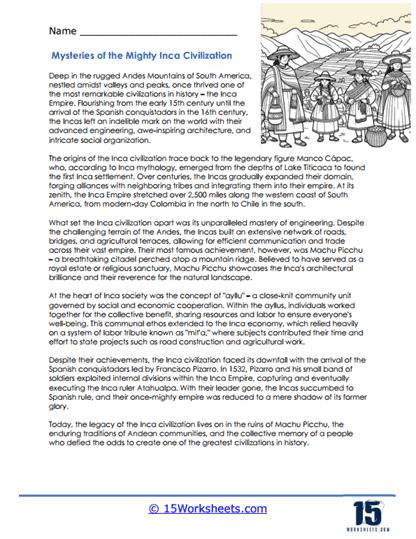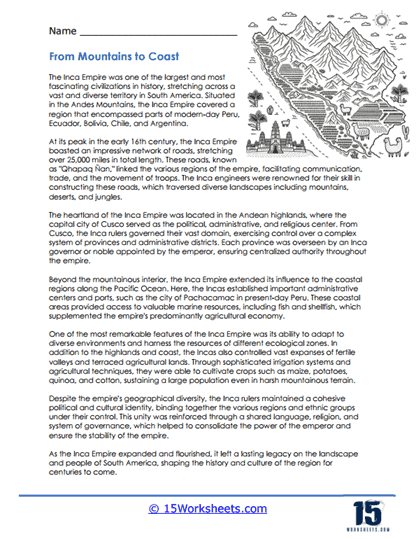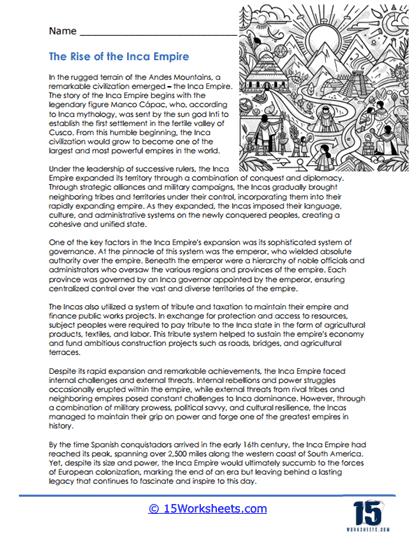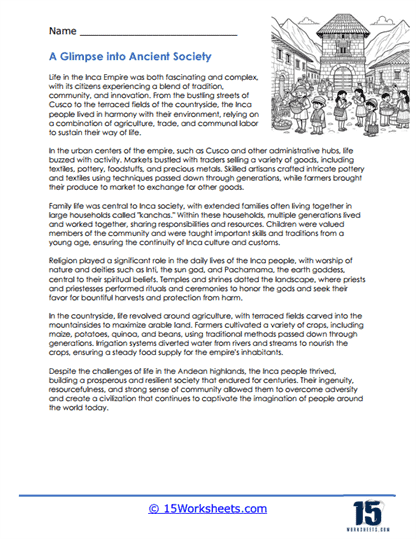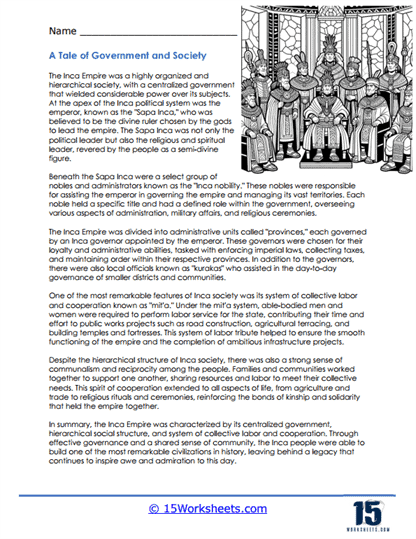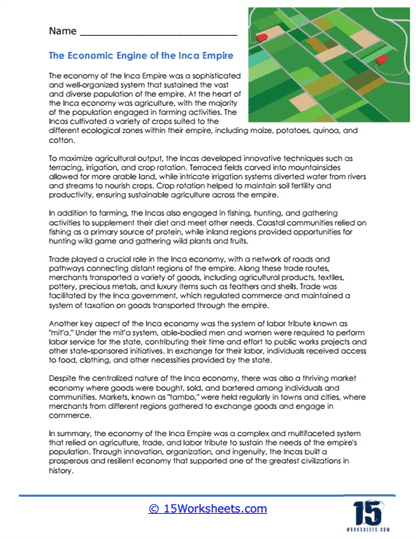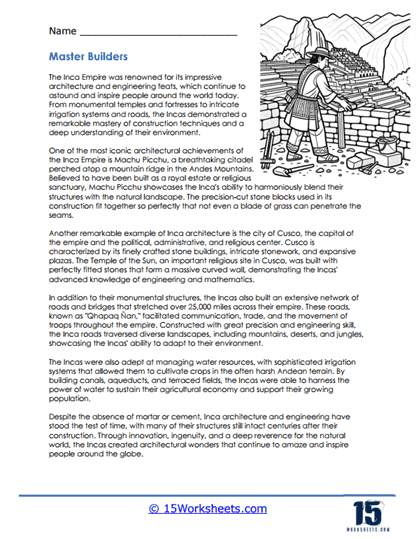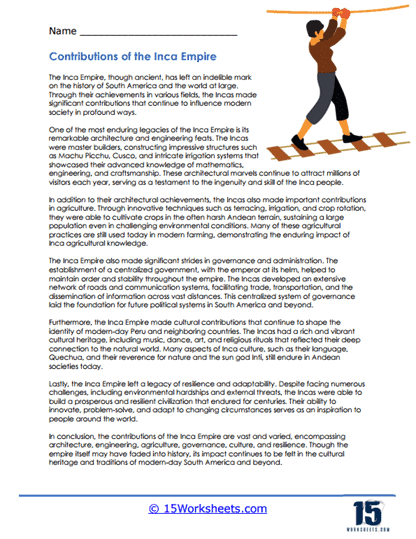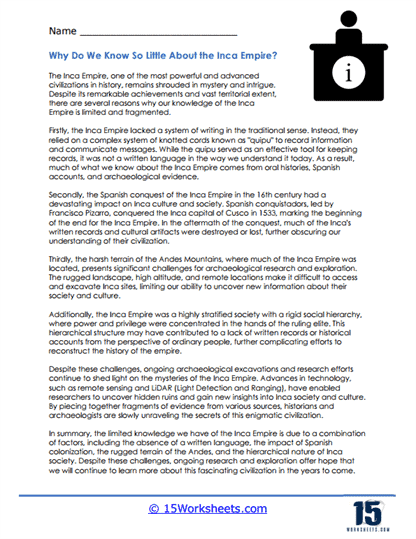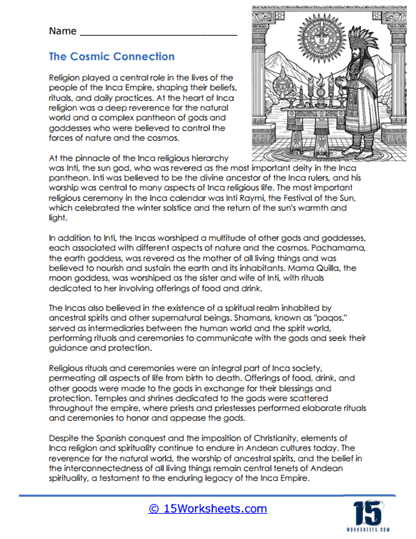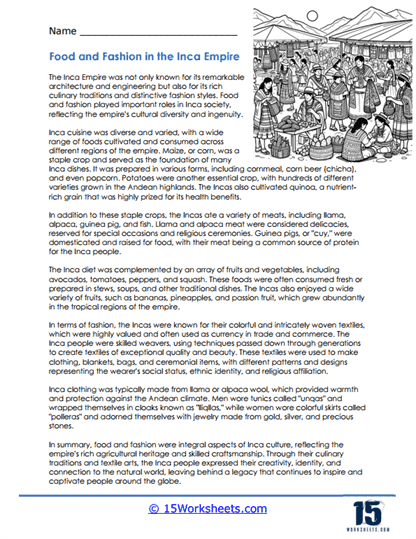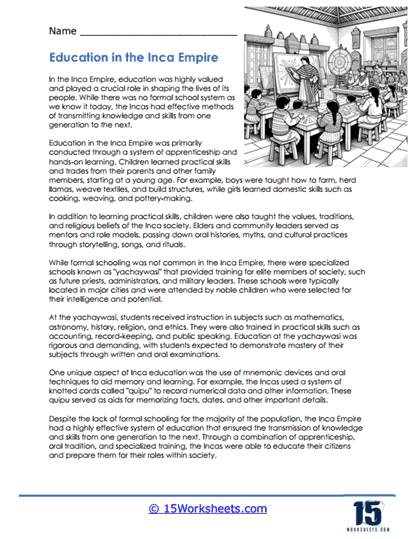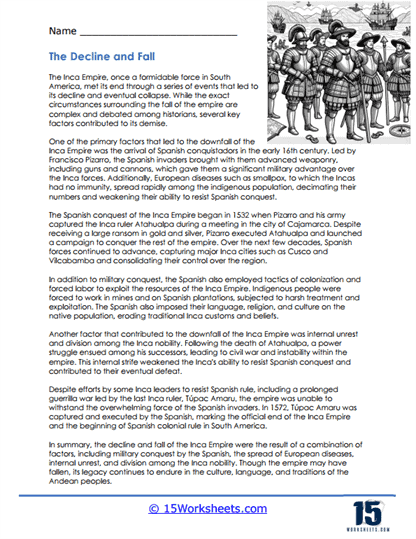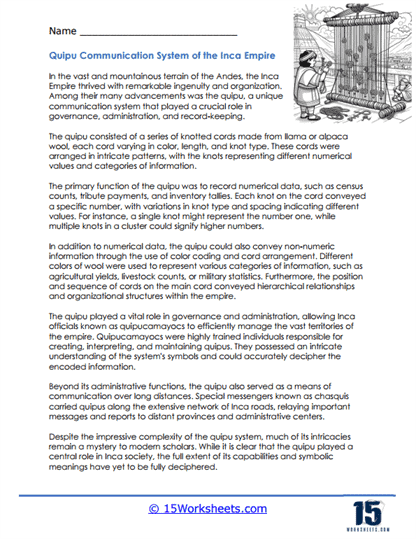Ancient Incas Worksheets
About These 15 Worksheets
Ancient Inca worksheets are educational materials designed to impart knowledge about the Inca civilization, which was one of the most notable pre-Columbian empires in South America. These worksheets are tailored to help students explore various aspects of Inca society, including their politics, economics, religion, architecture, and their eventual encounter with European explorers. The exercises on these worksheets are varied and aim to cater to different learning styles while ensuring a comprehensive understanding of the subject matter.
Through a diverse range of exercises, these worksheets not only enhance students’ historical knowledge and cultural understanding but also develop essential academic and real-world skills.
Types of Exercises
Timeline Construction – Students create timelines to chronologically arrange significant events in Inca history, such as the reigns of notable Sapa Incas (emperors), the construction of Machu Picchu, or the Spanish conquest. This helps them understand the sequence of historical events and their contexts.
Reading Comprehension – Worksheets often include passages about Inca history and culture, followed by questions testing students’ understanding of the text. These activities improve students’ ability to extract and interpret information from written material.
Fill-in-the-Blanks – These exercises provide a passage with missing words that students must fill in to complete the information about the Inca Empire. This can be used to reinforce vocabulary and concepts specific to the study of the Incas. By using clues related to the Inca civilization, students fill in the crossword puzzles. This method reinforces learning in a fun and engaging way, helping students retain facts and terminology.
Multiple Choice Questions – Students are presented with questions and several answer options about the Inca civilization’s various aspects. These questions assess students’ recall and understanding of the material studied.
Discussion Questions – Open-ended questions encourage students to think critically about the Incas, such as considering the impact of the Spanish conquest or discussing the achievements of Inca engineering. These activities promote analytical thinking and class discussions.
Essay Writing – Assignments may require students to write essays on specific topics, such as the role of religion in Inca society or the significance of the Inca Trail. Essay writing develops students’ abilities to organize their thoughts and present clear arguments.
Compare and Contrast Exercises – These worksheets may ask students to compare the Inca civilization with other contemporary cultures or civilizations. Through comparison, students identify unique features of the Incas as well as commonalities with other groups. To evaluate comprehension and retention of knowledge, quizzes and tests are often included. They may cover a broad range of topics about the Inca civilization and require students to demonstrate their learning progress.
The Benefits of These Worksheets
Our Ancient Inca worksheets can significantly enhance a student’s grasp of history and culture. These exercises ensure a multifaceted approach to learning, encompassing various educational strategies to suit different learning preferences.
Fostering Chronological Awareness – Timeline construction activities develop a student’s sense of chronology, crucial for understanding historical progression and the interrelation of events. Knowing the order of events aids in comprehending cause-and-effect relationships and the development of historical narratives.
Enhancing Cultural Literacy – Art and culture projects, along with reading comprehension exercises, deepen students’ understanding of the beliefs, values, and practices of the Inca civilization. A richer cultural literacy allows students to appreciate the diversity of human societies and the uniqueness of each cultural heritage.
Developing Geographical Knowledge – Mapping activities highlight the importance of geography in the development of civilizations. Students come to appreciate how the Andean terrain influenced Inca urban planning, agriculture, and trade routes, providing insights into the interaction between humans and their environment.
Encouraging Critical Thinking – Discussion questions and essay writing assignments challenge students to analyze information, synthesize knowledge from various sources, and articulate their viewpoints on complex historical issues. This hones critical thinking skills, which are applicable across academic disciplines and in everyday problem-solving.
Building Empathy and Perspective-taking – Role-play activities allow students to put themselves in the shoes of historical figures, fostering empathy and the ability to consider multiple perspectives. Understanding diverse viewpoints is essential for a well-rounded grasp of history and for developing social awareness in a global context.
Improving Memory and Retention – Fill-in-the-blanks, crossword puzzles, and quizzes aid in reinforcing memory retention. Repetition through these various formats helps cement students’ grasp of key terms and concepts.
Developing Comparative Analysis Skills – By comparing the Inca civilization to others, students develop the ability to identify both differences and similarities, fostering a more nuanced understanding of world history and intercultural connections.
Cultivating Communication Skills – Both written assignments and oral activities like discussions and role-playing promote the development of effective communication skills. Being able to convey information clearly and persuasively is a critical skill in any context.
Promoting Research Skills – Many of these exercises, especially essay writing, require students to conduct research, teaching them how to gather information, evaluate sources, and reference material correctly. These are fundamental skills for academic success and informed citizenship.
What Was the Ancient Inca Civilization?
The Ancient Inca civilization, known as Tawantinsuyu, was the largest empire in pre-Columbian America, and its administrative, political, and military center was located in Cusco in modern-day Peru. The Incas emerged as a distinct culture in the early 13th century, but it was under the leadership of Pachacuti Inca Yupanqui in the mid-15th century that the empire expanded significantly through a combination of diplomacy and military conquest.
The Inca way of life was intricately tied to their environment, social structure, and religious beliefs. The society was strictly hierarchical, with the Sapa Inca at the top, considered a divine ruler descended from the sun god Inti. Below the Sapa Inca were the nobility, priests, and administrators who managed the ayllus (extended family groups), and at the bottom were the common people, including farmers, artisans, and laborers.
The Incas excelled in agriculture, developing terrace farming to adapt to the Andean highlands. They grew a variety of crops such as potatoes, maize, quinoa, and cotton, and raised llamas and alpacas for wool, meat, and as beasts of burden. The Incas were skilled weavers, creating textiles that were highly valued and used as a form of tax payment along with agricultural produce.
The Inca economy was based on a system of reciprocal labor known as mit’a. Instead of a market-based economy, the Incas used this system to mobilize labor for large projects, such as building infrastructure or farming communal lands. In return, the workers were provided for by the state.
In terms of their social structure, the Incas practiced collective ownership of land, and the state played a significant role in the distribution of resources, ensuring that everyone had access to the necessities of life, a system that can be described as a form of welfare state.
The Inca religion was polytheistic, with Inti, the sun god, at the center of the pantheon. Religious observances included elaborate ceremonies and festivals, often marked by human and animal sacrifices. The Incas also practiced ancestor worship, mummifying their dead, particularly the nobility, and bringing them out on ceremonial occasions.
Contributions to Humanity
Engineering and Architecture
The Incas are widely celebrated for their architectural prowess, seen in iconic structures like Machu Picchu, Sacsayhuamán, and Ollantaytambo. They excelled in the construction of cities, temples, and fortresses with intricate stonework that required no mortar and has stood the test of time against earthquakes.
Their engineering marvels also included an extensive network of roads and bridges that connected the vast empire. The Qhapaq Ñan, or Great Inca Road, is one of the most impressive feats, stretching for thousands of miles and facilitating communication, trade, and military movements.
Agriculture
The Incas made significant advancements in agriculture, such as terrace farming, which allowed them to cultivate on the steep Andean mountainsides. They developed advanced irrigation systems and were one of the first civilizations to freeze-dry food, creating products like chuño (freeze-dried potatoes), which could be stored for years.
Social Organization
The Inca Empire was highly organized, with a complex administration that effectively managed the resources and labor force of the empire. This system ensured that despite the vastness of the empire, resources were distributed where needed, and large-scale infrastructure projects could be undertaken efficiently.
Textile Arts
Inca textiles were not only functional but also artistic expressions, with intricate designs that have influenced modern fashion. The Incas’ techniques in weaving, dyeing, and embroidery were highly sophisticated and formed a significant part of their economy and culture.
Medicine
The Ancient Inca civilization, although lacking the written records or scientific methodologies of the modern era, made significant advances in medicine that reflect a deep understanding of their environment and the human body. Their medical practices were closely tied to their spiritual beliefs, but they also included practical and surprisingly sophisticated techniques.
The Incas were skilled herbalists, utilizing a vast pharmacopoeia derived from the rich biodiversity of their empire, which spanned various ecological zones from the coast, through the highlands, to the Amazon rainforest. They used herbs to treat a wide array of conditions, from altitude sickness and digestive issues to wounds and fractures. Coca leaves, for instance, were chewed to alleviate hunger and fatigue and mitigate altitude sickness. Other plants, like the bark of the cinchona tree (from which quinine is derived), were used for treating fevers and possibly malaria.
The Incas’ medicinal practices were undoubtedly intertwined with their spiritual beliefs, often involving rituals and offerings to appease gods or ancestral spirits they believed could influence health. However, their practical medical knowledge, especially in the areas of herbal medicine and surgery, was quite advanced for their time. The legacy of their medical knowledge has transcended generations, and some aspects continue to be explored and respected within modern medicine, especially within the realm of alternative and holistic therapies.
Astronomy
The Incas had a keen understanding of astronomy, which they used for agricultural and religious purposes. They built observatories like the Intihuatana stone at Machu Picchu, which served as an astronomical clock or calendar to mark solstices and equinoxes.

